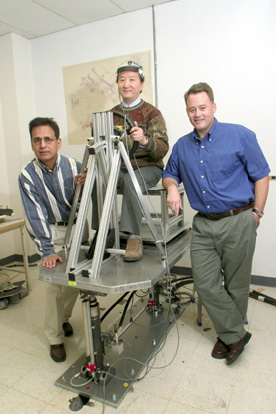Good vibrations for truck drivers

Subhash Rakheja, Shiping Ma, Richard DeMont
Photo by Andrew Dobrowolskyj
Bumpy rides and backaches are facts of life for most truck and tractor drivers. Now a team of Concordia professors hopes to make their lives run a lot smoother by reducing the estimated one million work-related injuries reported each year in Canada.
With two federal grant applications now pending, Mechanical and Industrial Engineering Professor Subhash Rakheja and Exercise Science Professors Richard DeMont and Shiping Ma hope to
continue pioneering research begun at Concordia in 1988 on the physical effects of whole-body vibration.
Their work has focused on vertical, or up-and-down, vibration. The team now wants to study horizontal, or fore-aft and side-to-side, vibration.
Their previous work has contributed to changes by manufacturers that included redesigned seats for some truck, race car and bus drivers. These may include a variety of air bags, heaters and fans, some with as many as 16 settings and costing between $3,000 and $5,000.
The team wants to turn its attention to other heavy-duty vehicles, such as those used in forestry, mining and extreme sports.
Anyone who watches Frontiers of Construction on television knows these monster machines, while impressive, probably present a range of new hazards for the driver, from lower back pain, including tissue rupture and inflammation, to significant stresses on upper limbs caused by oscillation.
The physiology of horizontal whole-body vibration has never been studied extensively, but the team believes its effects, while perhaps more subtle, are just as ruinous.
“It’s slow poison, and it’s hard to pinpoint,” said DeMont, who is also a
certified athletic therapist. He hopes to develop improved prevention methods and rehabilitation therapies.
Rakheja said industrial vehicles and some all-terrain recreational vehicles show little regard for the driver’s comfort. “They don’t consider the human factor. We know there are often more rollovers and flipovers with these vehicles.”
To simulate conditions and lengths of exposure, the team, based in the Concave facility on St. Jacques St., will use a modified version of its trusty accelerometer. Test subjects sit on a pressure-sensitive seat and are wobbled and turned at speeds raging from 0.5 hz to 10 hz.
Ma explained, “We need to observe the contraction of muscles. We want to know how the muscles stabilize the body [under these conditions].”
The grant applications include one to the Natural Science and Engineering Research Council for $120,000 annually over three years, and another to the Canadian Institute of Health Research for $90,000.
The funding would go toward the training of highly qualified students and research participation during the course of the three-year study, set to begin in the summer of 2005.